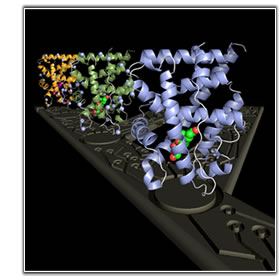
 The nuclear receptor superfamily of proteins respond to a wide range of ligands and regulate gene expression for numerous systemic processes.
The nuclear receptor superfamily of proteins respond to a wide range of ligands and regulate gene expression for numerous systemic processes.
Researchers in the Redinbo Laboratory study several aspects of nuclear receptor structure-function. In published work, we focus on the former human orphan receptors PXR, which responds to drugs, xenobiotics and endobiotics, and LRH-1, which is essential for early embryogenesis as well as adult homeostasis.
In addition, we investigated the early evolution of nuclear receptor structure by examining the 450-million year old ancestral precursors to the modern glucocorticoid receptors.
Our group has examined the structure and function of both ligand-binding and DNA-binding domains of nuclear receptors from human and other origins.
A representative set of publications is provided below:
Ortlund, E.A., Bridgham, J.T., Redinbo, M.R., and Thornton, J.W. (2007).
Crystal structure of an ancient protein: evolution by conformational epistasis.
Science, 317, 1544-1548.
Solomon, I.H., Hager, J.M., Safi, R., McDonnell, D.P., Redinbo, M.R., and Ortlund, E.A. (2005).
Crystal structure of the human LRH-1 DBD DNA complex reveals Ftz-F1 domain positioning is required for receptor activity.
Journal of Molecular Biology, 354, 1091-1102.
Ortlund, E.A., Lee, Y., Solomon, I.H., Hager, J.M., Safi, R., Choi, Y., Guan, Z., Tripathy, A., Raetz, C.R.H., McDonnell, D.P., Moore, D.D., and Redinbo, M.R. (2005).
Modulation of human nuclear receptor LRH-1 activity by phospholipids and SHP.
Nature Structural and Molecular Biology, 12, 357-363.
Watkins, R.E., Wisely, G.B., Moore, L.B., Collins, J.L., Lambert, M.H., Williams, S.P., Willson, T.M., Kliewer, S.A., and Redinbo, M.R. (2001).
The human nuclear xenobiotic receptor PXR: structural determinants of directed promiscuity.
Science, 292, 2329-2333.